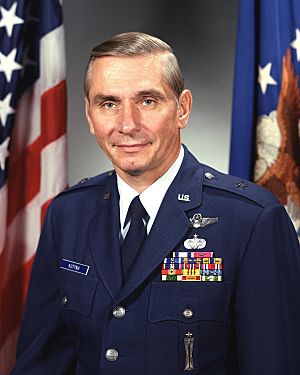Donald Kutyna facts for kids
Quick facts for kids
Donald J. Kutyna
|
|
|---|---|

Brigadier General Donald J. Kutyna in 1985
|
|
| Born | December 6, 1933 Chicago, Illinois |
| Allegiance | United States |
| Service/ |
United States Air Force |
| Years of service | 1957–1992 |
| Rank | General |
| Commands held | North American Aerospace Defense Command United States Space Command Air Force Space Command |
| Battles/wars | Vietnam War |
| Awards | Defense Distinguished Service Medal (2) Air Force Distinguished Service Medal Legion of Merit (2) Distinguished Flying Cross (2) Air Medal (9) |
| Other work | Rogers Commission Member |
General Donald Joseph Kutyna (born December 6, 1933) is a retired officer from the United States Air Force. He was a very important leader, serving as commander in chief of the North American Aerospace Defense Command (NORAD) and the United States Space Command from 1990 to 1992. Before that, he commanded the Air Force Space Command at Peterson Air Force Base, Colorado, from 1987 to 1990.
Contents
Becoming an Air Force Pilot
Donald Kutyna studied at the University of Iowa before joining the United States Military Academy. He graduated in 1957 with a science degree.
After finishing his pilot training in Oklahoma in September 1958, Kutyna became a combat crew commander. He flew the B-47 bomber until June 1963.
In June 1965, Kutyna earned another degree from the Massachusetts Institute of Technology. This time, it was a Master of Science in aeronautics and astronautics, which is the science of flight and space travel. After that, he worked at the Aerospace Research Pilot School in California. There, he helped train test pilots and astronauts for America's aviation and space programs.
Flying in the Vietnam War
From December 1969 to January 1971, Kutyna served in the Vietnam War. He flew 120 combat missions in the F-105 tactical fighter jet. He named his aircraft "The Polish Glider" as a joke about how the F-105 flew. This specific aircraft is now in the Polish Aviation Museum in Kraków, Poland.
After his time in Southeast Asia, Kutyna worked at the Air Force Headquarters in Washington, D.C. He helped plan new developments for the Air Force.
Working with Space Programs
In June 1982, General Kutyna took on a big role at Space Division in California. He became the deputy commander for space launch and control systems. In this job, he managed the Department of Defense's Space Shuttle program. This included designing and building a launch site for the space shuttle on the West Coast. He also helped get the special boosters needed to launch military payloads into space.
His work also involved developing and launching all Air Force rockets. These included the Titan and Atlas space boosters. He also worked with the Titan IV, a very powerful rocket that could carry as much as the space shuttle. He also helped improve the Air Force's satellite control network.
Investigating the Challenger Disaster
General Kutyna is well-known for his help in investigating problems with NASA space launches. He was a member of the Rogers Commission, a group that looked into the terrible accident of the Space Shuttle Challenger. The Challenger broke apart shortly after launch in 1986, and all seven astronauts on board were lost.
Kutyna was very concerned that NASA had continued to fly the shuttle even though they knew about a serious problem with parts called O-rings. He compared it to an airline letting a plane fly when one of its wings was about to fall off.
While on the commission, he became friends with Richard Feynman, a famous scientist. Feynman later wrote about their teamwork in his book What Do You Care What Other People Think?. Their partnership was very important in figuring out why the Challenger disaster happened.
Kutyna shared a key piece of information with Feynman. He told Feynman how he was fixing his car and noticed that some seals failed in cold weather. This made Feynman realize that the O-rings on the shuttle became stiff and lost their elasticity when it was cold, like on the morning of the accident. Kutyna later shared that Sally Ride, another commission member and astronaut, secretly gave him the information about the O-rings' behavior in cold temperatures. He kept this secret until she passed away in 2012.
The story of the Challenger investigation was made into a TV movie in 2013 called The Challenger Disaster. In the movie, Bruce Greenwood played General Kutyna.
In June 1986, Kutyna returned to Los Angeles Air Force Station. He became the vice commander of Space Division. Here, he oversaw all space system purchases, especially those related to the Strategic Defense Initiative.
Leading Air Force Space Command
In November 1987, General Kutyna became the commander of the Air Force Space Command. This was a new and important command for the Air Force. His forces were in charge of warning about missiles, watching space, and controlling satellites at 46 locations around the world. In April 1990, he also took command of the North American Aerospace Defense Command and the United States Space Command.
General Kutyna was a highly skilled pilot. He flew more than 4,500 hours in 25 different types of fighter jets and bombers. He received many military awards for his service. These include the Defense Distinguished Service Medal, the Air Force Distinguished Service Medal, and the Distinguished Flying Cross.
In June 1987, Kutyna received the National Geographic Society's General Thomas D. White U.S. Air Force Space Trophy. This award is given to someone who has made the most outstanding contribution to the nation's progress in space.
Donald Kutyna was promoted to General on April 1, 1990. He retired from the Air Force on June 30, 1992.

